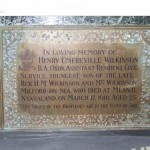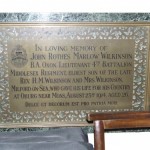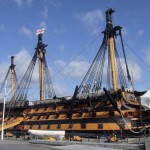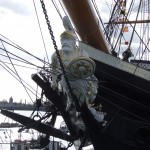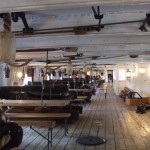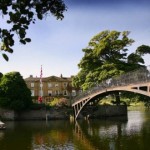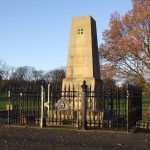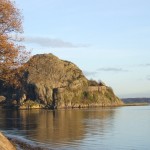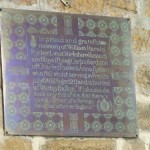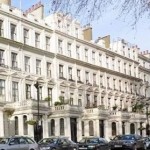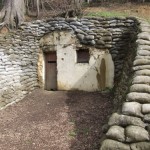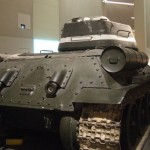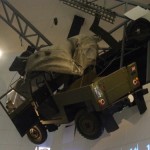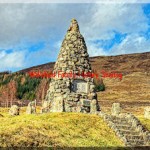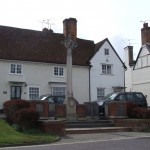The memorial to Henry can be found inside the church at Milton on Sea, but who was Henry ?
Well, he was the son of Henry Marlow Wilkinson (b 4 Aug. 1827 Godshill, I.O.W d 9 Dec 1908, Milford-on-Sea ) and his wife Florence Amy Kemp-Welch (b 1852 in Brixton, Surrey, died on 5 Jun 1927 in Milford on Sea) who married in Christchurch in the winter of 1886. Henry Marlow Wilkinson was a clergyman living with his wife, family and servants in Milford vicarage at the time of the 1901 census – Henry Umfreville was aged 10 and like his sister Marie he was not listed as a scholar. Henry Marlow was from a family of clergymen.
Ten years before in 1891, Henry Marlow Wilkinson was aged 63 while Florence his new wife was aged 38 and for children she had 3 under 5 – John, Cyril and Henry aged 10 months.
By the time of the 1911 census Florence was a widow and living at Milford Corner with her 4 children and 4 servants in a 17 roomed house. Good news for family historians Florence added that she had had 7 children but had lost 3 by the time of the census. Who were the other children ? In 1911 John Rothes Marlow Wilkinson was 23 and a student ; Cyril Hacket Wilkinson was 22 and a student ; Henry Umfreville Wilkinson was 20 and a student and finally, Marie Cecile Florence Wilkinson aged 17 and also a student.
From the memorial we know that Henry Umfreville was a student at Oxford and attained a B.A., he also was a member of the Civil Service and it was during this service in Mlanji, Nyasaland that he died on 17 March 1916 that he died aged 25. I’ve not found a lot about Henry but will his brother who was a soldier during the Great War be any different ?
John Rothes Marlow Wilkinson, as we know he was the elder brother of Henry U but he has more of a story to tell.
In the London Gazette John is mentioned as to be a Second Lieutenant in the Territorials dated 17 December 1909. Another mention gives information regarding Second Lieutenant Wilkinson being transferred from the 7th Bttn Hampshire Regt., to the Duke of Cambridge’s Own (Middlesex Regt.,) He was a University candidate on 24 March 1911but would not be getting pay of allowances prior to 7 February 1912.
Soldiers who Died in the Great War tells us information we have already gained from the London Gazette but that he was Killed in Action on 10th September 1914 near Mons. But a look at De Ruvigny’s Roll of Honour gives an insight as to who the young man was. He was a handsome young man, with I suppose you could say he had film star looks – well you could if this was the 1940’s or 50’s. He had good strong features and a neat moustache. His education was at Winchester College and Worcester College (1907-1911) and was Captain of the colleges boat club. We know he was killed near Mons, but what happened ? A Private from C Coy., 4th Middlesex Regt., wrote “On Sunday 23 August, we were entrenched in front of a convent, when Capt., …..gave Lieut. Wilkinson an order to take half his platoon (two sections) to reinforce A Coy. The Coy. was at the left of our positions and was hard pressed. We took up position under heavy fire at a group of houses. Your son went into one of the houses, and was heard directing the fire of his two sections through the skylight of the root. He directed his fire so well that he forced the Germans to retire from his front. it was from this house that he was overwhelming numbers of Germans coming through the wood to his front. The Germans came on again until they were within 200 yards. Lieut. Wilkinson came out of the house into the trench. It was here that he got the order to retire. He got the order twice, but would not take it, as he thought it was not an official order. Eventually he got the order from the G.O.C. to retire. It was then I noticed he was limping. To retire we had to go through barbed wire ; here we got separated owing to the heavy shell and rifle fire. I am very sorry to say that I was not the only man of those two sections to get away from that place. No officers could give me any information of Lieut. Wilkinson. I reported to the C.O. what had happened and told him that Lieut. Wilkinson was a very brave man. He replied, ‘Yes, I know that, and I am very sorry to have lost him’ … I must say your son was a man in very sense of the word. I think he was as brave a gentleman as one could meet here. I told this to Capt.,……. I think I have an idea of a brave officer, as I went through the South African War and have eight clasps to my medal” Such sad news for a family to hear but good to know that a Private thought enough of his Lieutenant to write to his family and inform them what really happened. So many other families could only wonder or imagine the fate of their loved one.
He was 26 years old when he was KIA and rests in St. Symphorien Military Cemetery, Hainaut, nr Mons, Belgium.
Within a two year period Florence had lost another two of her boys but she did live on for another few years.
Papers of the Wilkinson of Milford family can be found in the Bodleian Library
James Marlow Wilkinson was one of over 2000 people who corresponded with Darwin
Roll of honour of sons and daughters who gave their lives in the Great War
